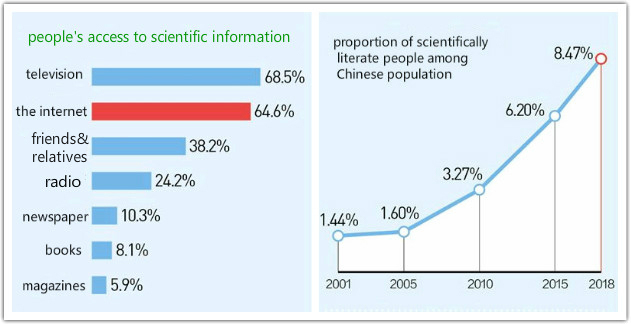China sees increase in public scientific literacy

Television and the internet are major accesses to scientific information.The proportion of scientifically literate people in China has increased from 1.44 percent to 8.47 percent between 2001 and 2018. Photo: CSST
In 2018, 8.47 percent of China’s population qualify as scientifically literate, a 2.27 percentage point growth in three years, according to the 10th National Report on Scientific Literacy. The results were released during the recent World Conference on Science Literacy in Beijing.
The report is the outcome of a survey that involved over 60,000 people aged from 18 to 69 from 31 provincial-level regions of China’s mainland. It investigates public scientific knowledge, learning and attitudes, said He Wei, a research fellow from the China Research Institute for Science Popularization. China aims to increase the ratio of science literate people to 10 percent or above by 2020 so that the country will have sufficient talent in technology to become an innovation-based country.
In terms of cities, public scientific literacy conforms to social and economic development. Ten cities outscore the national average, of which Beijing and Shanghai rank at the top two with more than 20 percent of their citizens scientifically literate.
As for regions, the Beijing-Tianjin-Hebei Metropolitan Region, the Yangtze River Delta and the Pearl River Delta take the lead countrywide. Also, “the gender gap and the divide between rural and nonrural Chinese have been closing since the survey was last conducted in 2015,” He said. For example, rural residents are catching up, as nearly 5 percent of them have the basic level of scientific literacy necessary to understand media reports about science. The figure has increased by 2.5 percentage points on 2015, outpacing the increase of 1.83 percentage points in urban areas. Also, people born in the 1980s and 1990s have better scientific literacy, preparing China to promote innovation across the country, He said.
It is notable that there is a decline of performance among people with high educational backgrounds, including high school, junior college and university graduates. This is the first decrease since the first survey, indicating that the well-educated in China are making slow progress in developing science literacy. Scholars suggested bringing the quality of science education to attention.
The report says that television and the internet are people’s major points at access to scientific information, of which China’s instant messaging application WeChat and China’s search engine giant Baidu are the main online sources.
Meanwhile, scientific popularization activities are expanding their role. Of the people surveyed, 21.5 percent and 18.7 percent attended scientific exhibitions and lectures respectively, and 15.3 percent of them participated in other forms of scientific activities last year, marking significant increases since 2015. People have more opportunities to acquire scientific knowledge and information. Last year, 58 percent of the surveyed people visited zoos, while about 32 percent went to aquariums or botanical gardens. Nearly 30 percent of those surveyed visited technology venues or natural museums.
The survey shows that the public in China maintain positive attitudes toward science and technology. They are supportive of basic scientific research.
Wang Kangyou, director of the China Research Institute for Science Popularization, attributed the increased scientific literacy to China’s greater efforts in scientific popularization. The country has doubled down on investment, leading to fast growth of infrastructure and professionals dedicated to promoting science among the public, Wang said.
Science popularization involved a total of 1.85 million personnel in 2016, an increase of nearly 230,000 since 2006. During the same period, China has tripled its exhibition space to 2.8 million square meters, as it had established 920 scientific museums by 2016. China has been active in opening scientific resources to the public. In 2017, people could visit 138 scientific exhibition centers across China for free. As a result, these venues attracted more than 40 million visits.
Unsatisfactory public scientific literacy holds China back from pushing innovation. The imbalanced development among regions forms another challenge. For example, the supply of excellent resources for science popularization is insufficient in China. The country also needs to improve its ability to promote science and spread appreciation of the scientific spirit. The sector is focusing on how to shake off the traditional ways and ideas of disseminating scientific information.
In the long run, a more mature market can better popularize science. It is reasonable to allow governments to take the lead while market operation plays a supportive role. “Market force will drive science popularization to be more effective. Only if consumers are involved can more quality works be created,” Wang added.
The article was translated from People’s Daily.
(edited by MA YUHONG)
